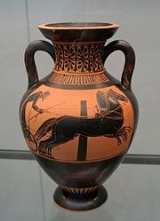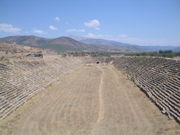
Hippodrome
Encyclopedia

Horse racing
Horse racing is an equestrian sport that has a long history. Archaeological records indicate that horse racing occurred in ancient Babylon, Syria, and Egypt. Both chariot and mounted horse racing were events in the ancient Greek Olympics by 648 BC...
and chariot racing
Chariot racing
Chariot racing was one of the most popular ancient Greek, Roman and Byzantine sports. Chariot racing was often dangerous to both driver and horse as they frequently suffered serious injury and even death, but generated strong spectator enthusiasm...
. The name is derived from the Greek words "hippos (ἵππος; "horse") and "dromos" (δρόμος; "race" or "course"). Some present-day horse racing tracks are also called hippodromes, for example the Central Moscow Hippodrome
Central Moscow Hippodrome
Central Moscow Hippodrome, founded in 1834 is the largest horse racing track as well as horse breeding research facility in Moscow and Russia.-External links:...
.
The Greek hippodrome was similar to the Roman
Roman Empire
The Roman Empire was the post-Republican period of the ancient Roman civilization, characterised by an autocratic form of government and large territorial holdings in Europe and around the Mediterranean....
Circus
Circus (building)
The Roman circus was a large open-air venue used for public events in the ancient Roman Empire. The circuses were similar to the ancient Greek hippodromes, although serving varying purposes. Along with theatres and amphitheatres, Circuses were one of the main entertainment sites of the time...
, except that in the latter only four chariots ran at a time, whereas ten or more contended in the Greek games, so that the width was far greater, being about 400 ft (121.9 m)., the course being 600 to 700 ft (213.4 m). long. The hippodrome was not a "Roman amphitheatre
Amphitheatre
An amphitheatre is an open-air venue used for entertainment and performances.There are two similar, but distinct, types of structure for which the word "amphitheatre" is used: Ancient Roman amphitheatres were large central performance spaces surrounded by ascending seating, and were commonly used...
" which was used for spectator sports, games and displays, or a Greek or Roman semi-circular theater used for theatrical performances.
The Greek hippodrome was usually set out on the slope of a hill, and the ground taken from one side served to form the embankment on the other side. One end of the hippodrome was semicircular, and the other end square with an extensive portico
Portico
A portico is a porch leading to the entrance of a building, or extended as a colonnade, with a roof structure over a walkway, supported by columns or enclosed by walls...
, in front of which, at a lower level, were the stalls for the horse
Horse
The horse is one of two extant subspecies of Equus ferus, or the wild horse. It is a single-hooved mammal belonging to the taxonomic family Equidae. The horse has evolved over the past 45 to 55 million years from a small multi-toed creature into the large, single-toed animal of today...
s and chariots. At both ends of the hippodrome there were posts (termai) that the chariots turned around. This was the most dangerous part of the track, and the Greeks put an altar to Taraxippus
Taraxippus
The Taraxippus was a presence, either a ghost or a site, that frightened the horses during races at the Panhellenic Games....
(disturber of horses) there to show the spot where many chariots wrecked.
A large ancient hippodrome was the Hippodrome of Constantinople
Hippodrome of Constantinople
The Hippodrome of Constantinople was a circus that was the sporting and social centre of Constantinople, capital of the Byzantine Empire. Today it is a square named Sultanahmet Meydanı in the Turkish city of Istanbul, with only a few fragments of the original structure surviving...
, built between AD 203 and 330. However, since it was built to a Roman design, it was actually a circus
Circus (building)
The Roman circus was a large open-air venue used for public events in the ancient Roman Empire. The circuses were similar to the ancient Greek hippodromes, although serving varying purposes. Along with theatres and amphitheatres, Circuses were one of the main entertainment sites of the time...
.

List of Greek Hippodromes
- DelosDelosThe island of Delos , isolated in the centre of the roughly circular ring of islands called the Cyclades, near Mykonos, is one of the most important mythological, historical and archaeological sites in Greece...
- DelphiDelphiDelphi is both an archaeological site and a modern town in Greece on the south-western spur of Mount Parnassus in the valley of Phocis.In Greek mythology, Delphi was the site of the Delphic oracle, the most important oracle in the classical Greek world, and a major site for the worship of the god...
- IsthmiaIsthmiaIsthmia is a noun meaning "of the isthmus"It may refer to:* The ancient Isthmian Games* The archaeological site related to the Games, including the Temple of Poseidon at Isthmia* The modern village of Isthmia...
- Lykaion http://corinth.sas.upenn.edu/lykaion/ly-plan.html
- NemeaNemeaNemea is an ancient site near the head of the valley of the River Elissos in the northeastern part of the Peloponnese, in Greece. Formerly part of the territory of Cleonae in Argolis, it is today part of the prefecture of Corinthia...
- OlympiaOlympia, GreeceOlympia , a sanctuary of ancient Greece in Elis, is known for having been the site of the Olympic Games in classical times, comparable in importance to the Pythian Games held in Delphi. Both games were held every Olympiad , the Olympic Games dating back possibly further than 776 BC...
http://www.sciencedaily.com/releases/2008/07/080714145253.htm
See also
- Beirut HippodromeBeirut HippodromeThe Beirut Hippodrome, officially called Hippodrome Du Parc De Beyrouth, is a horse-racing facility in Beirut, Lebanon. It was built in 1885 in Bir Hassan, a suburb of Beirut...
- The Hippodrome at Caesarea
- Kensington HippodromeKensington HippodromeThe Kensington Hippodrome was a racecourse built in Notting Hill, London, in 1837, by entrepreneur John Whyte. Whyte leased of land from James Weller Ladbroke, owner of the Ladbroke Estate, and proceeded to enclose "the slopes of Notting Hill and the meadows west of Westbourne Grove" with a high...
- Hippodrome of ConstantinopleHippodrome of ConstantinopleThe Hippodrome of Constantinople was a circus that was the sporting and social centre of Constantinople, capital of the Byzantine Empire. Today it is a square named Sultanahmet Meydanı in the Turkish city of Istanbul, with only a few fragments of the original structure surviving...
- New York HippodromeNew York HippodromeThe Hippodrome Theatre, also called the New York Hippodrome, was a theatre in New York City from 1905 to 1939, located on Sixth Avenue between 43rd and 44th Streets in the Theater District of Midtown Manhattan. It was called the world's largest theatre by its builders and had a seating capacity of...
Theatre - Bristol HippodromeBristol HippodromeThe Bristol Hippodrome is a theatre in the centre of Bristol, England with seating on three levels giving a capacity of 1,951. It frequently features West End theatre shows when they tour the UK as well regular visits by Welsh National Opera, and an annual pantomime.- History :The theatre was...
Theatre - Sport venueSport venueSport venue is an arena, a stadium or similar building in which a sporting competition is held.-Types of sports venues:*Sport hall*Motorsport venues *Horse racing venues *Swimming pool*Shooting range*Bullring...
- Circus (building)Circus (building)The Roman circus was a large open-air venue used for public events in the ancient Roman Empire. The circuses were similar to the ancient Greek hippodromes, although serving varying purposes. Along with theatres and amphitheatres, Circuses were one of the main entertainment sites of the time...

